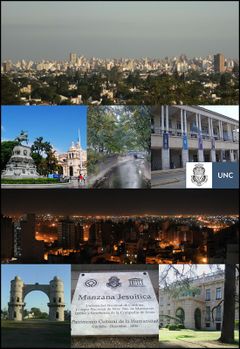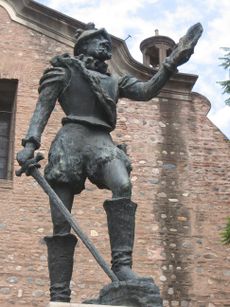قرطبة، الأرجنتين
Córdoba | |
|---|---|
City | |
| Ciudad de Córdoba | |
 Cityscape taken from Naciones Park, San Martin Square, La Cañada Glen, Argentina Pavilion from National University of Córdoba, Cityscape at night taken from Nueva Cordoba neighborhood, Arch of Córdoba, Plaque commemorating the designation of the Jesuit block as World Heritage Site in 2000, Evita Fine Arts Museum. | |
 | |
| الإحداثيات: 31°25′S 64°11′W / 31.417°S 64.183°W | |
| Country | |
| Province | |
| Department | Capital |
| Established | 1573 |
| السمِيْ | Córdoba, Spain |
| الحكومة | |
| • Mayor | Ramón Javier Mestre (UCR) |
| المساحة | |
| • البر | 576 كم² (222 ميل²) |
| المنسوب | between 352 and 544 m (between 1٬154٫86 and 1٬784٫78 ft) |
| التعداد (2010 census) | |
| • الكثافة | 2٬273٫5/km2 (5٬888٫46/sq mi) |
| • Urban | 1٬317٬298 |
| • العمرانية | 1٬528٬000 (est) |
| [1] | |
| منطقة التوقيت | UTC−3 (ART) |

Córdoba (النطق الإسپاني: [ˈkorðoβa]) is a city in the geographic center of Argentina, in the foothills of the Sierras Chicas on the Suquía River, about 700 km (435 mi) northwest of the Buenos Aires. It is the capital of Córdoba Province and the second most populous city in Argentina after Buenos Aires, with about 1,330,023 inhabitants according to the 2010 census. It was founded on 6 July 1573 by Jerónimo Luis de Cabrera, who named it after Córdoba, Spain. It was one of the first Spanish colonial capitals of the region that is now Argentina (the oldest city is Santiago del Estero, founded in 1553). The National University of Córdoba is the oldest university of the country and the seventh to be inaugurated in Spanish America. It was founded in 1613 by the Jesuit Order. Because of this, Córdoba earned the nickname La Docta (roughly translated, "the learned one").
Córdoba has many historical monuments preserved from Spanish colonial rule, especially buildings of the Roman Catholic Church. The most recognizable is perhaps the Jesuit Block (Spanish: Manzana Jesuítica), declared in 2000 as a World Heritage Site by UNESCO[2] which consists of a group of buildings dating from the 17th century, including the Colegio Nacional de Monserrat and the colonial university campus. The campus belongs today to the historical museum of the National University of Córdoba, which has been the second-largest university in the country since the early 20th century (after the University of Buenos Aires), in terms of the number of students, faculty, and academic programs. Córdoba is also known for its historical movements, such as Cordobazo and La Reforma del '18 (known as University Revolution in English).
. . . . . . . . . . . . . . . . . . . . . . . . . . . . . . . . . . . . . . . . . . . . . . . . . . . . . . . . . . . . . . . . . . . . . . . . . . . . . . . . . . . . . . . . . . . . . . . . . . . . . . . . . . . . . . . . . . . . . . . . . . . . . . . . . . . . . . . . . . . . . . . . . . . . . . . . . . . . . . . . . . . . . . . .
Image gallery
See also
References
- ^ "INDEC: estimaciones de población" (PDF). Archived from the original (PDF) on 9 April 2014. Retrieved 2014-04-22.
{{cite web}}: Unknown parameter|deadurl=ignored (|url-status=suggested) (help) - ^ UNESCO World Heritage Centre (2000-11-30). "UNESCO". Whc.unesco.org. Retrieved 2014-04-22.
Notes
External links
- Pages using gadget WikiMiniAtlas
- CS1 errors: unsupported parameter
- Short description is different from Wikidata
- Coordinates on Wikidata
- Pages using infobox settlement with unknown parameters
- Pages with empty portal template
- Official website different in Wikidata and Wikipedia
- قرطبة، الأرجنتين
- Populated places in Córdoba Province, Argentina
- عواصم محافظات الأرجنتين
- Populated places established in 1573
- World Heritage Sites in Argentina
- Cities in Argentina
- 1573 establishments in the Spanish Empire
- 1573 establishments in South America
















